

Last updated on
March 18, 2024
Email marketing is dying, or so people thought. Nothing can be further from the truth.
Not only is email marketing alive, but it is getting even more vital. The number of emails sent and received continues to increase yearly.
Based on statistics, it reached a whopping 319.6 billion per day in 2021. This translated to total annual revenue of around $8.49 billion globally.
That said, the success or failure of your email campaign rests primarily on your content strategy. You must do more than just send generic messages to your email subscribers and expect breakthrough results. Your email content has to be compelling.
Before you start working on your email marketing campaigns, you must first understand what email content is.
Email content is a message you send to a current customer or a prospect at any stage of the customer lifecycle. You can generally do it in one of three ways:
● Craft and send the email messages personally
● Use an automation platform
● Use a dedicated but comprehensive email builder
The email subject line can cover several topics, including product announcements, brand promotions, and the like. We will be discussing each of them in detail later on.
In terms of length, the content can be standard, short-form, or long-form. Standard emails are generally 100 words long, short-form messages are around 50, and long-form emails are 150 words or longer. (source)
Whether you send short or full-fledged messages will depend on the nature of the email. Auto replies are typically shorter than full-fledged newsletters.
Many companies write emails to prospective customers at every stage of the customer journey, and they are an integral part of an overall marketing strategy.
A well-implemented email marketing campaign can help even small businesses reach their target audience and forge a stronger connection with existing customers. It offers a great way to generate leads and build brands.
Once a potential customer joins your email list, you can routinely send them relevant content that can make their lives easier in some way.
It can involve a sales pitch or an offer only sometimes. You could also give them valuable information to help meet a need or solve a problem.
If you have social media accounts on multiple platforms, you could create emails to boost your presence on those channels. Doing this will give people more opportunities to get to know your brand voice, increase engagement, and raise your credibility.
The best part about a compelling marketing email is that it is cost-effective and offers a fast return on investment. Industry experts believe every dollar you spend on a good email marketing strategy can give you back $36 of earnings.

Gone are the days when emails sounded very formal. They now come in various tones, depending on the communication preferences of the recipient.
This emerging trend allows you to speak directly to your target audience in a way they can relate to. That said, emails still follow specific formats. Here are the top ones:
A weekly newsletter is email content you send to different segments of your target audience every week. Its goal is to accomplish these three objectives:
● Share information about your business, like the latest updates or new products. It allows you to maintain top-of-mind awareness among old and new subscribers.
● Increase brand awareness and make sure that you have engaged subscribers who look forward to receiving helpful information from you.
● Build trust between you and your target audience so that when your subscribers receive an email from you, they won't ignore it.
Newsletters help your entire list of subscribers by providing helpful information.
On the other hand, email marketing content is designed to promote your products and services. It is the best format to use if you want people to know about your offerings or ongoing discounts.
Email marketing helps with lead generation and building customer relationships. It also offers an excellent way to educate current and potential customers about the value of your brand.
It is an effective direct marketing tool that keeps people engaged between purchases.
Dynamic content is a part of the email body that changes depending on the behavior or preferences of the recipient. These are messages based on segmented data such as age, gender, and location.
It is an important content format because it allows you to simultaneously send a personalized message to both old and new subscribers.
Certain parts of the email content will just vary depending on the characteristics that you will determine. This feature will come in handy when you want to send email blasts but don’t want to come across as generic.
It saves you a lot of time and energy because subscribers expect a personalized experience at every touchpoint.
One of the worst fears of any business is having a disastrous email campaign performance. Nobody wants to waste time, energy, and marketing dollars on messages that will just gather dust in the reader's inbox.
You must be on point when creating content for your messages to ensure this does not happen to you. Here are five of the most prominent types of email content you could use:
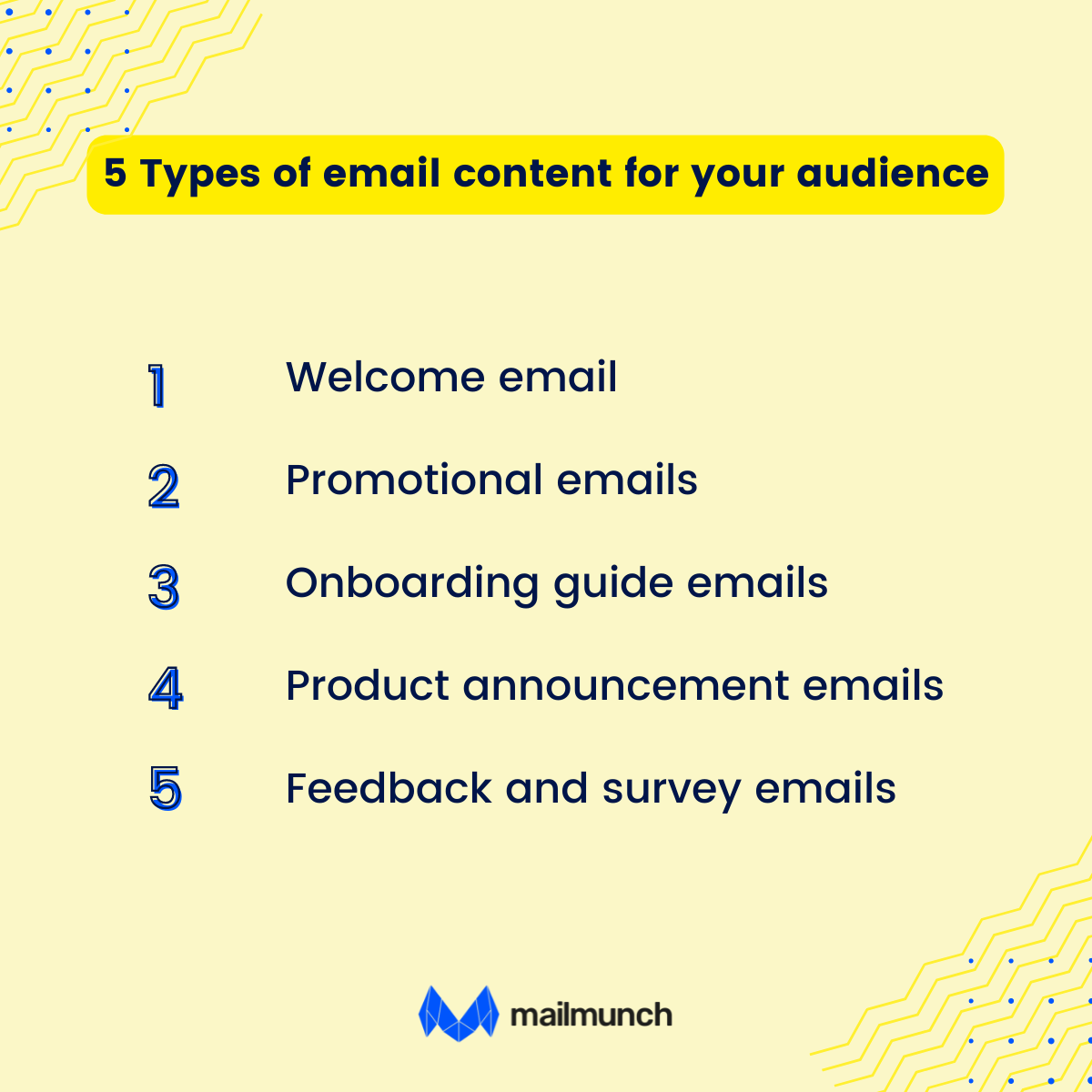
The welcome email is one of the first messages people receive once they sign up or subscribe to a service. After giving out their contact information to an eCommerce store, it is also the first email they get.
At this point, you have closed a sale or secured a subscription. So why is the welcome email still so important?
Remember that your ultimate goal as a business is more than just to close a deal with a customer once. What you want is to have a loyal customer that keeps coming back for more.
For this to happen, you must convince them that your brand is worth sticking around for. Sending them a well-crafted welcome message is a big step in this direction. It creates an excellent first impression that could lay the groundwork for a long business relationship.
Promotional emails are messages businesses send to convince their subscribers to purchase. They often include various incentives to drive conversion and revenue.
While most people expect to receive a welcome email when they subscribe to something, many are weary of promotional emails. They have had their fill of overzealous messages that push them to buy or subscribe without offering anything else that is engaging.
This type of email content is still an essential part of every marketing strategy. Besides, there are ways to write a promotional email that offers a good mix of promotions and other helpful content.
Creating a new blog post, onboarding guide, or any other content will help attract more visitors to your website. You can generate even more interest by telling everyone on your contact list about it.
The best way to do this is by sending an onboarding guide email highlighting the best parts of your new content. It should have a compelling CTA that will encourage the readers to download the rest of the blog or guide.
Aside from this, you could also tell your subscribers about your new content in your weekly or monthly newsletters.
Whatever your business model, you must develop ways to keep your customers engaged. So even if you have successfully launched products in the past, you can't use it as an excuse to relax.
Being stagnant is the quickest way for people to forget about you, no matter how successful you were in the past.
The best way to remind your customers that you still exist is to come up with new products or services from time to time. You have to tell them about it every time you do so through product announcement emails.
Product announcement emails are messages businesses send to people to showcase an exciting new product. It contains a compelling sales pitch that will capture the reader's attention.
To stay ahead of the competition, businesses must continuously improve. It applies to their portfolio of products or services and their internal processes.
The question is, "How do you get useful insights and accurate information to guide your efforts toward improvement?" There are many possible answers in today's data-driven world, but one of the most reliable options is to gather honest feedback through surveys, as per the CEO of HowSociable.
A quick email to your contact list will allow you to collect valuable information you can use to improve. It eliminates the guesswork, which means you can make big business decisions more confidently.
At this point, you know the most prominent email content formats and types. However, you need more than this information to launch a successful email marketing campaign. You must know how to construct emails that resonate with your target audience.
Note that consumer behavior changes depending on emerging trends and technologies. In other words, what works well today may be less effective tomorrow.
These are the current best practices when writing compelling email content:

You must first remember that you are not writing for yourself. You are sending an email to people who are on your contact list.
You must speak in a tone they can understand and relate to. The challenge is knowing what your target audience is thinking.
Note that while they are all interested in your brand and have that to share in common, each of them is still a unique individual.
How do you connect with such a diverse group at a meaningful level? Again, this is where surveys can come in handy.
You can send an email blast containing a short questionnaire that won’t take too much of your customers’ time to answer. You can just gather the data and analyze it using different survey tools.
Another great way to see the world through your customers' eyes is to interact with them where they often congregate. Make sure you have a presence on popular social media platforms so people can engage with your brand.
Building on the previous tip, you must write a literary piece regarding email content. You are writing a message designed to eventually compel your customers to take action, whether to download, click a link, or make a purchase.
Given these conditions, you could not afford to play around with your customers’ time using big words and complex ideas. You need to be clear and concise.
Each statement should lead to your ultimate goal: to convert a reader into a loyal customer. For this to happen, your language has to be clear and straightforward. Set a clear and to-the-point tone in your emails. Remove repetitiveness, unnecessary details, and jargon wording from your writing. An email online summarizer can help you with such a task.
This is separate from the intellect of your target audience. It is based on the fact that they need more patience to plow through tons of text just to get to the core of your idea.
That is especially true today when people’s attention span has dropped to as low as eight seconds.
Make sure you inject your brand voice and have fun with it; your reader will also do so.
If you ask any marketer how long an email’s subject line should be, many of them would tell you to target nine words. That is how small your wiggle room is in conveying the topic of your email.
As you can imagine, trying to capture the essence of your message in a few words can be challenging. Nevertheless, you need to align your subject line with the content of your email.
A good subject line does not just tell the recipient what the email contains. It communicates a promise of value.
What’s in it for them? Why should they spend a few minutes reading your message? More importantly, why should they open your email instead of all the other messages in their inboxes?
We live in a fast-paced business environment where consumers are constantly bombarded with emails. That is why most people only spend six seconds deciding whether to open your email.
You need to make each second count by telling them clearly what your email is about and how reading it will benefit them.
Once you have convinced the reader to open your email, you need to make it worth their while. Make sure your copy lives up to the promise of your subject line.
There are many ways to do this, but two of the most effective ones are being clear and personalizing.
Remember that most people need more time or patience to figure out an ambiguous or confusing message. If they think your email takes too much effort to read, they will abandon it.
What is worse is that the next time they see an email from you, they might decide not to read it at all.
On the other hand, personalizing your email content helps make your message stand out. Personalization tokens can insert the recipient’s name, location, or business name.
These tools can make your email appear more intimate, allowing you to connect with your target audience at a deeper level.
A conversational tone is another good way to connect with your target audience. This applies to most forms of marketing, but it is even more true for email marketing.
Why? Note that people will receive your message individually, whether you send an email blast to your entire contact list or a particular group. It allows you to talk directly to the person you sent the email to.
Writing in the third person in this situation will make you seem too detached or impersonal. If you keep on saying “he,” “she,” or “them,” the reader might not find it engaging. You are talking at them instead of to them.
A better option is to write in the second person. Doing this would make the reader feel included. You can even throw in a few first-person references to make the communication more personal.
If you own or run a business, it is only natural that you feel passionate about it. You are happy about your products, enthusiastic about your manufacturing processes, and proud of your team.
If anyone listens to you, you could go on for hours gushing about any or even all of them. However, you should resist this urge when writing your email, especially if the content is about something else.
Again, this goes back to the fact that most people prefer to spend less time reading their emails. You can’t afford to go off-topic, even if it is for something that would make you look good.
Think about it: they read your subject line and opened your email with certain expectations. If they end up seeing something else that is irrelevant to the topic, they will feel disappointed.
We have mentioned in passing what’s in the mind of most people before opening every email. They are asking themselves, “What’s in it for me?” It is understandable, given how many hours they spend at the office, in traffic, doing household chores, and whatnot.
They have little time left for themselves, so why should they spend a part of it reading your email?
An excellent answer to this question, according to the owner of Likes.io is that you will give them something valuable in return. It only applies to information about your brand or industry that they might find helpful.
It could come in the form of content that is entertaining. You could offer them a freebie or a discount for your latest or most popular products.
The key is to make them feel that they will be rewarded for giving you a few minutes of their precious time.
Most business owners know their products inside out, from every critical component to the best features. That is why it is straightforward for them to talk about these characteristics instead of how their offering can help consumers.
To illustrate, think about a simple item like a lawn mower with a unique feature where the user can fold the handles. Most people would focus on the collapsible handles instead of highlighting the benefit that the product is easier to store.
Every time you build your email content, ensure that your readers know the value of what you are offering. While giving them relevant information, it is equally important that you show them how valuable the data is.
Whether you are selling a car or a pair of basketball shoes, you can’t just say, “Please buy this product.” This is especially true if it is your prospect’s first encounter with your brand.
Most buyers go through a lengthy process of discovery, interest, desire, purchase, and, ideally, loyalty. Each stage requires a different approach or marketing strategy.
So first, make sure that you tell potential customers a compelling brand story. Knowing what your business is about will make a prospect more likely to trust you.
You could also give them helpful information about your industry, like a tutorial or a how-to guide.
You can start talking about your products or services and highlighting their benefits. These benefits must match the needs or wants of the individual.
Finally, when they are ready, you can reel them in with a good deal by offering a discount or some form of incentive. You could also try upselling or cross-selling to keep them coming back for more.
The point here is that you shouldn’t sell to prospects yet in the conversion stage. Otherwise, your run the risk of appearing overly aggressive and end up scaring them away.
Anyone with social media accounts probably heard of FOMO or “fear of missing out.”
FOMO started with a negative connotation because it described how certain people became anxious when looking at other people’s posts. You would feel left out if you constantly see idealized versions of your friend’s experiences.
Marketers are using a similar strategy to encourage people to take action, whether downloading an app, clicking a link, or buying a product. You can use it too in your email content.
There are several ways to do this, like offering a time-sensitive promo or showing other people enjoying your product. The key is to make them feel they will miss out on something special if they ignore your message.
One of your main goals as a business or brand is to connect with as much of your target audience as possible. The good thing is that there are many ways to expand your reach.
Even better, you can do some of the work in some cases. For instance, you can encourage people to share your content with those they think would be interested in your email.
Now, there is a chance that they would forward your content to others, but there is also a chance that they won’t. This method is effective because it would be to high-quality prospects if they share your email.
So every time you send an email, ensure it has a Share button.
At this point, you know how important it is to help your prospect solve a problem or explain the benefits of your products. You also know that you should butter them up before making your pitch.
It is time to put in your finishing touch: a well-crafted CTA.
An email CTA or call-to-action is exactly what it sounds like—you are explicitly telling the readers what you want them to do.
When writing a CTA, be as clear as possible. Use compelling words but do not beg them to click, download, or buy anything. Instead, tell them what’s in store for them if they do.
To give you more insight into how to write a good email, here are some examples using different formats:

This email from People Data Labs offers code examples to potential subscribers. It is clear and concise but conveys the benefits of getting the lead magnet effectively.

This is the first email that Reigning Champ sends to its new subscribers. It offers access to additional offerings, encouraging repeat business.

This email from Monday.com follows up on a potential subscriber that still needs to finish the sign-up process.
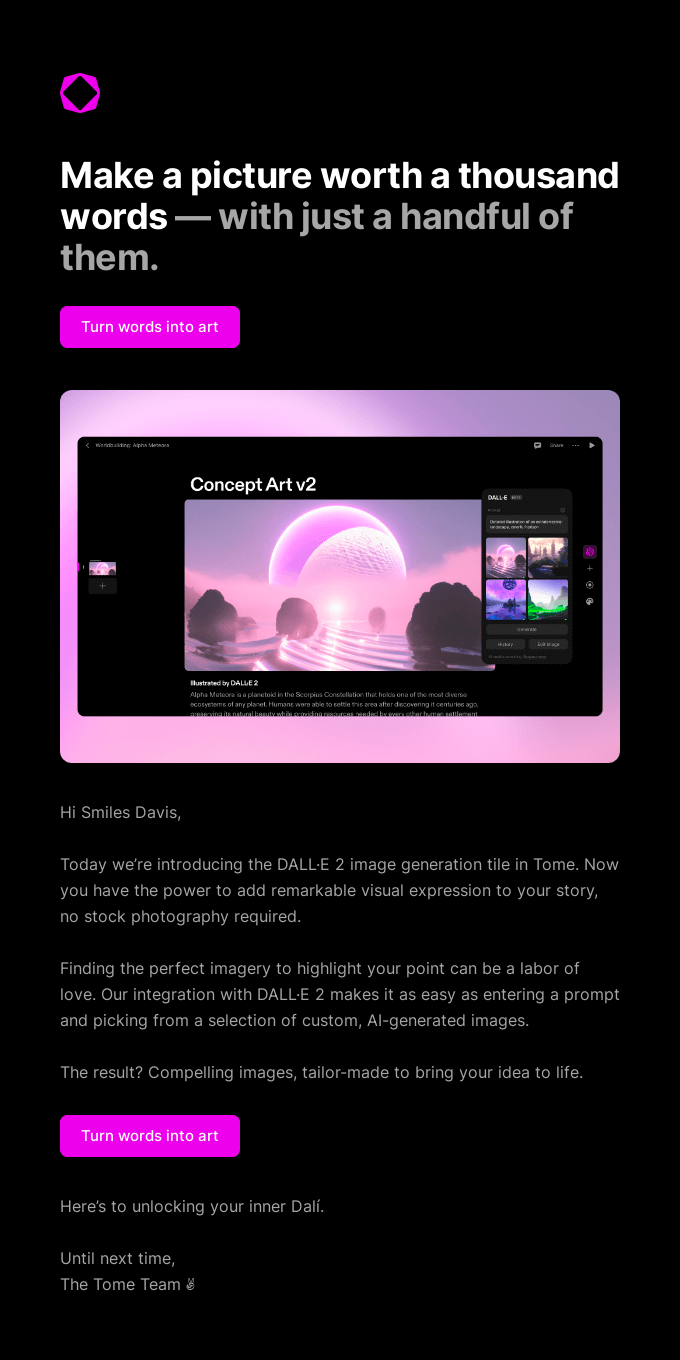
This product launch email from Tome does an excellent job of appealing to its niche audience. It cleverly highlights a unique selling point and outlines its benefits.

This email from Zapier asks new subscribers for feedback. It guarantees beforehand that the survey won’t take long, maximizing the chances of getting a response.

In this email, DocuSign is offering discounts on all its plans. It uses the FOMO strategy by giving the offer a deadline.
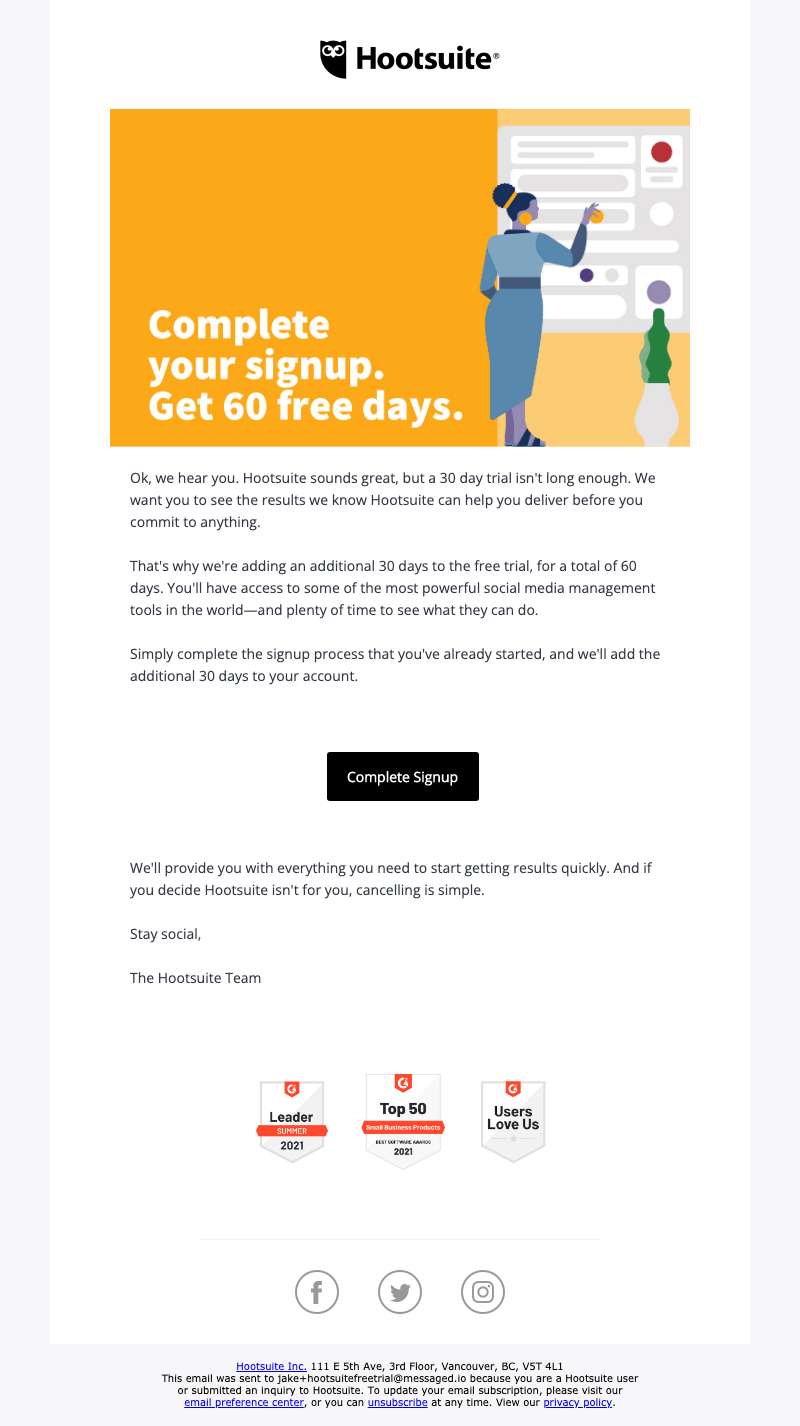
This email from Hootsuite tries to reengage subscribers who finished a 30-day trial but did not upgrade to a paid plan.

This email from Parsley Health educates readers about the industry that it is in and encourages them to call. From there, the company can get valuable information that would help it develop a more accurate buyer persona.

This email delivers the latest updates about Waymo and opens up with an engaging hook.

Courier provided a sneak peek into their latest story on the creative industry in this blog post update.
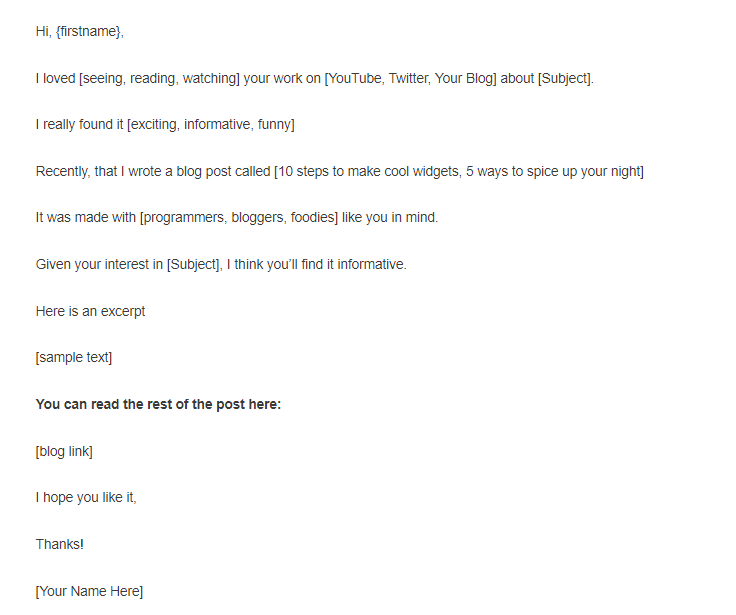
This is a template for a blog promotion email for different niche markets.

This template is helpful if you want to reach out to a blog site and see if you can post content as a guest.
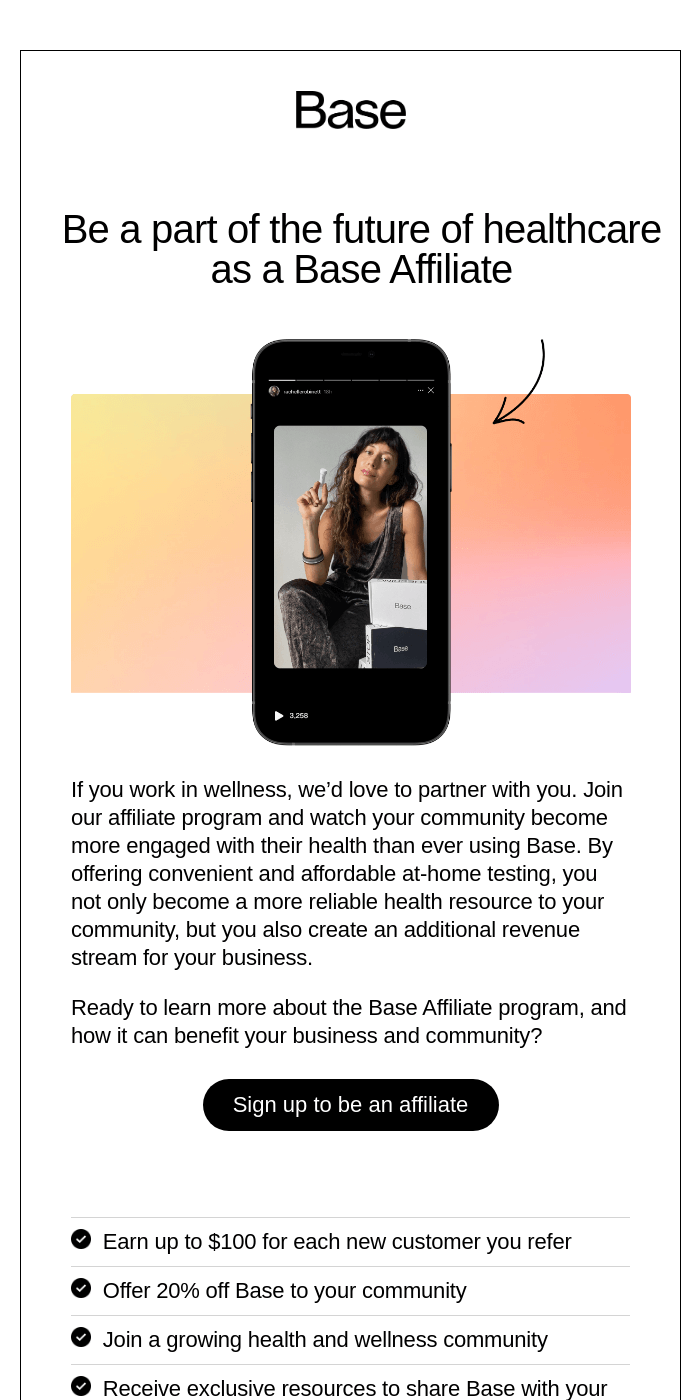
This email from Base reaches out to potential affiliates by outlining the benefits of being one. They even threw in a compelling testimonial.

One good way to convince someone to join your podcast is to tell them how you love their work. This email template does a good job of that.

This example sales pitch email from TaskRabbit has a compelling subject line, and its content is consistent with the topic.

This email template is for a roundup email where you can work with multiple influencers by asking them their take on specific topics.
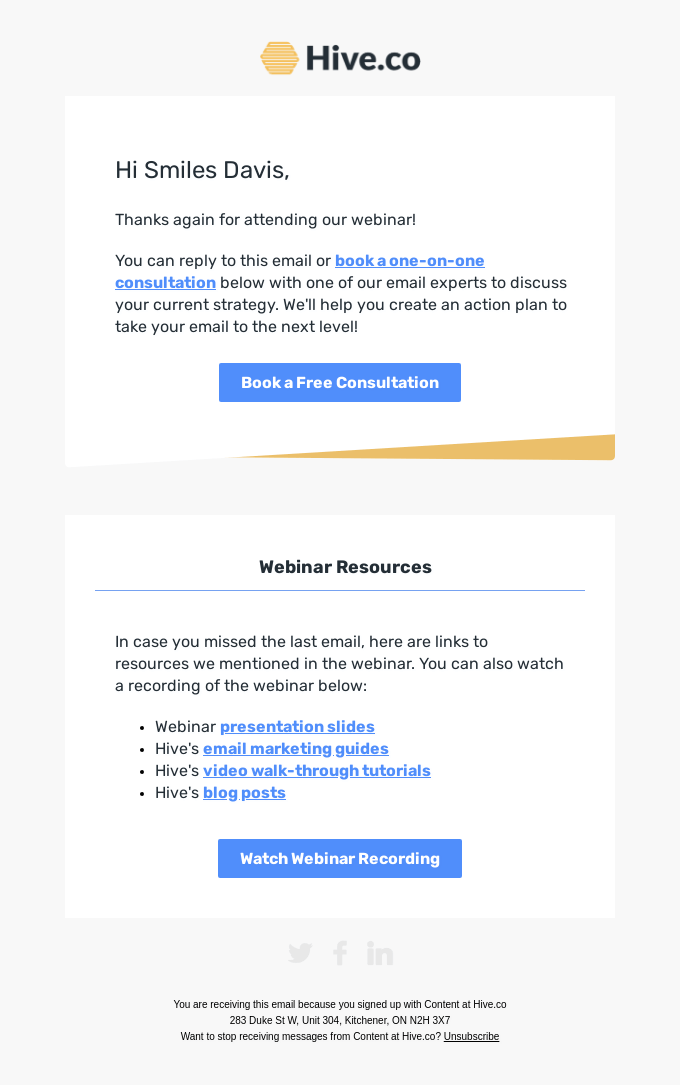
This sample email is from Hive. co asks a recent webinar participant to book a free consultation and even provides a recording of the webinar as a bonus.
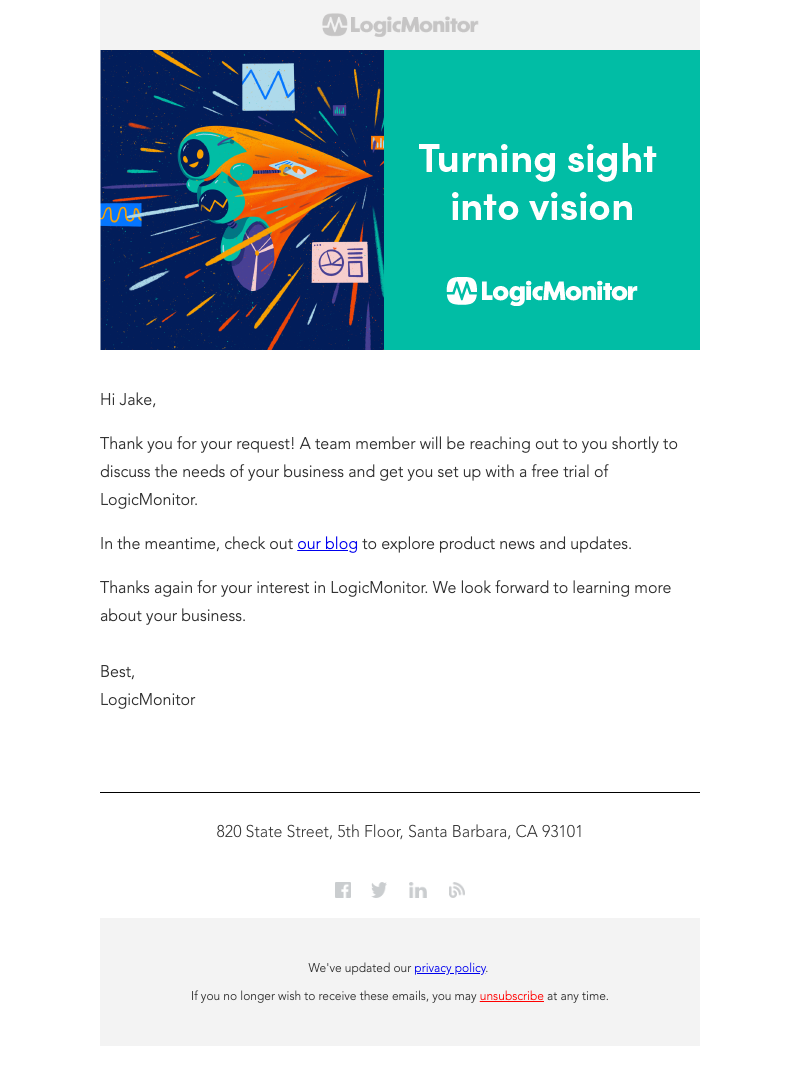
This email assures a potential client that someone from LogicMonitor will contact them shortly to discuss their request.
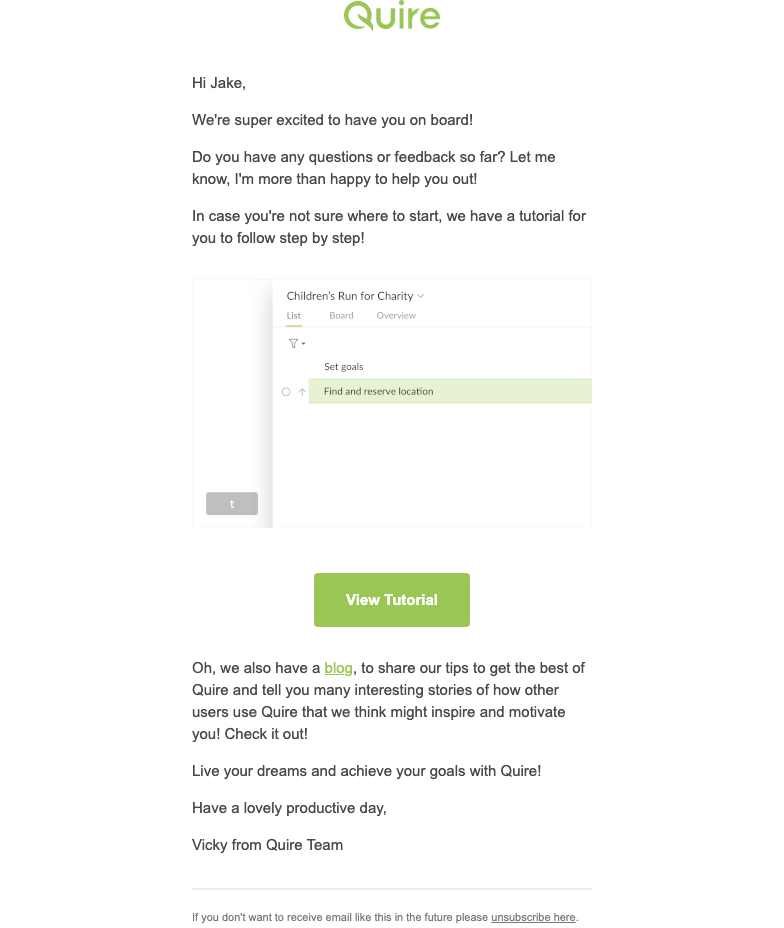
With this email, Quire welcomes a new client by offering access to a helpful tutorial and informative blogs.

This email from Asana asks a current subscriber to provide feedback and offers a chance to win a prize in return.
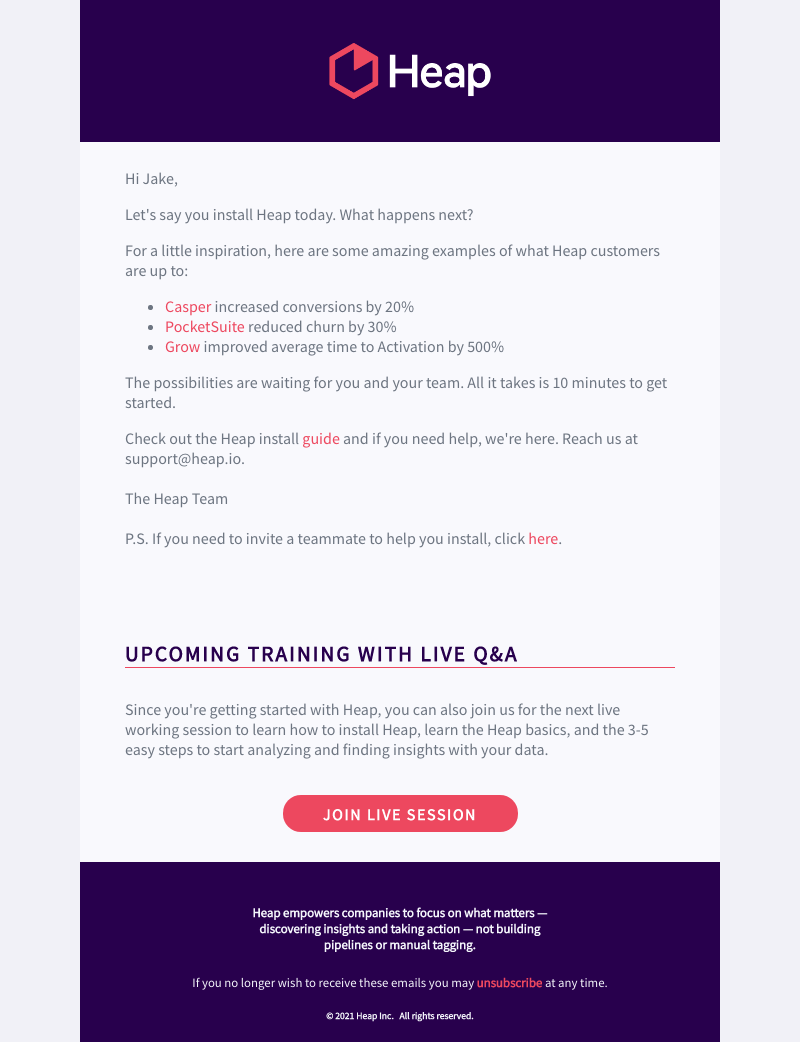
Heap is trying to promote a lead magnet (Guide) and extend an invitation to a live working session with this email.
Nothing beats a solid email campaign for engaging prospects, and no other company is better than Mailmunch. Here at Mailmunch, we have all the tools you need to grow your email list, generate leads, and maximize conversion.
So let us help you send stunning emails that captivate your target audience.
Now that you’ve got a good idea of email content and its importance in marketing your brand, products, and services, allow us to answer two of the top questions about email marketing:
This marketing strategy involves sending prospects emails to promote your brand or your products and services.
Email marketing campaigns are easy to launch and do not cost much. Moreover, they are very effective because they connect you with an engaged audience.
A voracious reader and a music lover, Ammar has been writing engaging and informative content for over 3 years for B2B and B2C markets. With a knack for writing SEO-optimized content, Ammar ensures the results speak for themselves.
Tags:

M. Usama
April 19, 2024

M. Usama
April 19, 2024

M. Usama
April 18, 2024